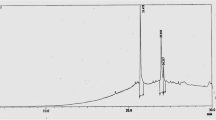Abstract
The present study was conducted to demonstrate the antioxidant and anticancer effects of methanol extract of the aerial parts of Aerva lanata Linn. In vitro antioxidant potentiality was tested using DPPH radical scavenging test, total phenol and flavonoid content and reducing power determination assays. The extracts showed moderate antioxidant activity in a dose dependent manner. In vivo anticancer activity was studied against Ehrlich Ascites Carcinoma (EAC) cells in Swiss albino mice by monitoring parameters like tumor weight measurement, survival time and tumor cell growth inhibition. It has been found that the compound at the dose of 40 mg/kg/day (i.p) significantly decreases tumor weight, increases life span and reduces tumor cell growth rate in comparison to those of EAC bearing mice receiving no extract. These results suggest that methanol extract of the aerial parts of Aerva lanata could be a source of natural anticancer and antioxidant compounds. In vitro cytotoxicity of the same extract was also assessed to link the finding with the potent anticancer activity of the experimental extract (LC50 less than 50 μg/ml).






Similar content being viewed by others
References
Alam MA et al (2008) Antioxidant and hepatoprotective action of the crude methanolic extract of the flowering top of Rosa damascena. Oriental Pharmacy and Experimental Medicine 8:164–170
Abbot BJ (1976) Bioassay of plant extracts for anticancer activity. Cancer Treat Rep 60:1007–1017
Chowdhury D, Sayeed A, Islam A, Bhuiyan MSA, Khan GRMAM (2002) Antimicrobial activity and cytotoxicity of Aerva lanata. Fitoterapia 73:92–94
Milovanovic V, Radulovic N, Todorovic Z, Stankovic M, Gordana SG (2007) Antioxidant, antimicrobial and genotoxicity screening of hydro-alcholic extracts of five Serbian Equisetum species. Plant Food Hum Nutr 62:113–119
Chinery R et al (1997) Antioxidant enhances the cytotoxicity of chemotherapeutic agents in colorectal cancer: a p53-independent induction p21 via C/EBP-beta. Natural Medicine 3:1233–1241
Dulger B, Gonuz A (2004) Antimicrobial activity of some Turkish medicinal plants. Pakistan Journal of Biological Science 7:1559–1562
Denny B, William A (1995) Chemical processes in New Zealand: the design and development of anticancer drugs. New Zealand Institute of Chemistry, New Zealand
Zapesochnaya GG, Pervykh LN, Kurkin VA (1991a) A study of the herb Aerva lanata. III. Alkaloids. Chem Nat Comp 27:336–340
Holland JF et al (1997) Cancer Medicine, Vol (1), 4th edn. MD: Williams and Wilkins, Baltimore, pp 261–276
Hasan MS et al (2006) Antioxidant, antinociceptive activity and general toxicity study of Dendrophthoe falcata and isolation of quercetin as the major component. Oriental Pharmacy Experimental Medicine 6:355–360
Kumaran A, Karunakaran AJ (2007) In vitro antioxidant activities of methanol extracts of five Phyllanthus species from India. LWT –Food Science and Technology 40:344–352
Larkson BD, Burichenal JH (1965) Preliminary screening of antineoplastic drugs. Prog Clin Cancer 1:625–629
Litchfield JT, Wilcoxon F (1949) A simplified method of evaluating dose-effect experiments. J Pharmacol Exp Therapeut 96:99–113
Meyer BN et al (1982) Brine Shrimp: a convenient general bioassay for active constituents. Planta Med 45:31–32
Manokaran S et al (2008) Hepatoprotective activity of Aerva lanata Linn. Against Paracetamol induced hepatotoxicity in rats. Res J Pharm Technol 4:398–400
Newman RA, Yang P, Pawlus AD, Block KI (2008) Cardiac glycosides as novel cancer therapeutic agents. Mol Interv 8:36–49
Oyaizu M (1986) Studies on product of browning reaction prepared from glucose amine. Jpn J Nutr 44:307–315
Price VE, Greenfield RE (1958) Anemia in cancer. Adv Cancer Res 5:199–200
Rashid MA, Hasan CM, Choudhury SAR, Begum B, Rahman S (1997) Ethnopharmacological investigation of medicinal plants of Bangladesh. Bangladesh J Physiol Pharmacol 12:25–29
Rao SG (1985) Evaluation of an experimental model for studying urolithiasis effect of Aerva lanata on urinary stones. Indian Drugs 22:640–643
Robert J (1999) Multi drug resistance in oncology: diagnostic and therapeutics approaches. Eur J Clin Invest 29:536–545
Sreenivasan Y, Raghavendra PB, Manna SK (2006) Oleandrin mediated expression of Fas potentiates apoptosis in tumor cells. J Clin Immunol 26:308–322
Schmitt CA, Lowe SW (1999) Apoptosis and therapy. J Pathol 187:127–137
Singelton VR, Orthifer R, Lamuela-Raventos RM (1999) Analysis of total phenols and other oxidation substrates and antioxidants by means of Folin-Ciocalteu reagent. Methods Enzymol 299:152–178
Sur P, Ganguly DK (1994) Tea Plant Root Extract (TRE) as an Antineoplastic Agent. Planta Med 60:106–109
Tushar A et al (2008) Antihyperglycaemic activity of alcoholic extract of Aerva lanata (L.) A. L. Juss. Ex J. A. Schultes leaves in alloxan induced diabetic mice. J Appl Biomed 6:81–87
Udupihille M, Jiffry MTM (1986) Diuretic effect of Aerva lanata with water, normal saline and coriander as controls. Indian J Physiol Pharmacol 30:91–97
Vetrichelvan T et al (2000) Diuretic and anti inflammatory activities of Aerva lanata in rats. Indian J Pharm Sci 62:300–302
Winnicka W, Bielawski K, Bielawska A (2006) Cardiac glycosides in cancer research and cancer therapy. Acta Pol Pharmaceutica 63:109–115
Xie Z, Cai T (2003) Na+-K+-ATPase-mediated signal transduction: from protein interaction to cellular function. Mol Interv 3:157–168
Xie Z (2001) Ouabain interaction with cardiac Na+-K+-ATPase reveals that the enzyme can act as a pump and a signal transducer. Cell Mol Biol 47:383–390
Yamunadevi M, Wesely EG, Johnson MA (2011) Chromatographic study on the glycosides of Aerva lanata L. Chin J Nat Med 9:210–214
Zapesochnaya GG, Pervykh LN, Kurkin VA (1991b) A study of the herb Aerva lanata. III. Alkaloids. Chem Nat Comp 27:336–340
Acknowledgments
The authors thanks to Prof. Dr. Jahanara Khanom (Department of Biochemistry and Molecular Biology, University of Rajshahi, Bangladesh) for providing the EAC cells and also to Prof. Dr. Shaikh Bokhtear Uddin (Department of Botany, University of Chittagong, Bangladesh) for identification of the plant.
Author information
Authors and Affiliations
Corresponding author
Rights and permissions
About this article
Cite this article
Raihan, O., Brishti, A., Bahar, E. et al. Antioxidant and anticancer effect of methanolic extract of Aerva lanata Linn. against Ehrlich Ascites Carcinoma (EAC) in vivo. Orient Pharm Exp Med 12, 219–225 (2012). https://doi.org/10.1007/s13596-012-0073-3
Received:
Accepted:
Published:
Issue Date:
DOI: https://doi.org/10.1007/s13596-012-0073-3




